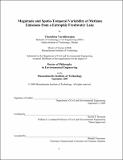| dc.contributor.advisor | Harold F. Hemond. | en_US |
| dc.contributor.author | Varadharajan, Charuleka, 1980- | en_US |
| dc.contributor.other | Massachusetts Institute of Technology. Dept. of Civil and Environmental Engineering. | en_US |
| dc.date.accessioned | 2010-05-25T19:23:12Z | |
| dc.date.available | 2010-05-25T19:23:12Z | |
| dc.date.copyright | 2009 | en_US |
| dc.date.issued | 2009 | en_US |
| dc.identifier.uri | http://hdl.handle.net/1721.1/54879 | |
| dc.description | Thesis (Ph. D.)--Massachusetts Institute of Technology, Dept. of Civil and Environmental Engineering, 2009. | en_US |
| dc.description | This electronic version was submitted by the student author. The certified thesis is available in the Institute Archives and Special Collections. | en_US |
| dc.description | Cataloged from student submitted PDF version of thesis. | en_US |
| dc.description | Includes bibliographical references. | en_US |
| dc.description.abstract | Methane is the second most important greenhouse gas after carbon dioxide, and it can significantly impact global climate change. Considerable amounts of methane can be released to the atmosphere from freshwater lakes, particularly through bubbling. However, spatial and temporal heterogeneity in ebullition has complicated efforts to accurately measure such methane emissions. This thesis presents the results from a two-year study of methane biogeochemistry conducted at the eutrophic, stratified, Upper Mystic Lake located in eastern Massachusetts, US. Field sampling was done between June and November 2007, and between April and November 2008. In both years, ebullition at the lake was strongly episodic, and the amount and composition of bubbled gas varied considerably between sites. In 2008, under-water bubble traps were equipped with pressure sensors that measured the gas collected every 5 minutes for 4-6 months. The high-temporal resolution data showed that synchronized lake-wide bubbling episodes were triggered when hydrostatic pressures fell below a site-dependent threshold. Twice as much bubbling was observed in 2007 than in 2008. In both years, approximately 70% of the total methane export from the lake occurred through ebullition, and 30% through diffusion across the air-water interface at the lake surface. About 6-11 kg CH4/d was emitted to the atmosphere from the Upper Mystic Lake during the sampling periods of 2007 and 2008. | en_US |
| dc.description.abstract | (cont.) The results from this research indicate that freshwater lakes should be considered as important natural sources in the global methane budget. Other contributions include the development a low-cost, low-power bubble trap for automated measurement of ebullition. The electronics in this device can also be used to measure other phenomena where a pressure differential is of interest, such as lake water level. To our knowledge, there has been no previous study that has measured bubbling fluxes over a comparable period of time with such high temporal resolution. Finally, the wavelet transform is presented as a new tool for identification of bubbling events from sensor data at multiple time scales. | en_US |
| dc.description.statementofresponsibility | by Charuleka Varadharajan. | en_US |
| dc.format.extent | 243 p. | en_US |
| dc.language.iso | eng | en_US |
| dc.publisher | Massachusetts Institute of Technology | en_US |
| dc.rights | M.I.T. theses are protected by
copyright. They may be viewed from this source for any purpose, but
reproduction or distribution in any format is prohibited without written
permission. See provided URL for inquiries about permission. | en_US |
| dc.rights.uri | http://dspace.mit.edu/handle/1721.1/7582 | en_US |
| dc.subject | Civil and Environmental Engineering. | en_US |
| dc.title | Magnitude and spatio-temporal variability of methane emissions from a eutrophic freshwater lake | en_US |
| dc.type | Thesis | en_US |
| dc.description.degree | Ph.D. | en_US |
| dc.contributor.department | Massachusetts Institute of Technology. Department of Civil and Environmental Engineering | |
| dc.identifier.oclc | 613206408 | en_US |
